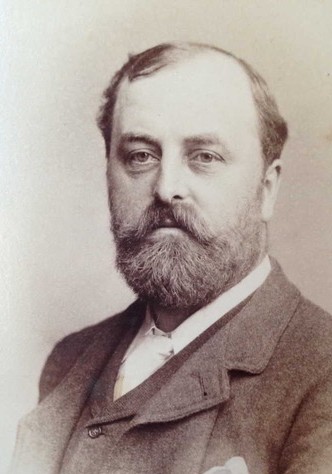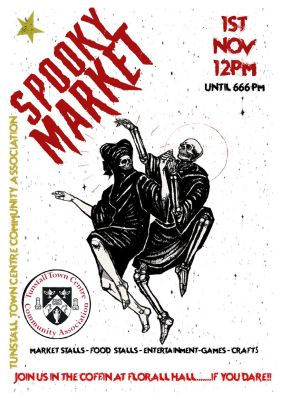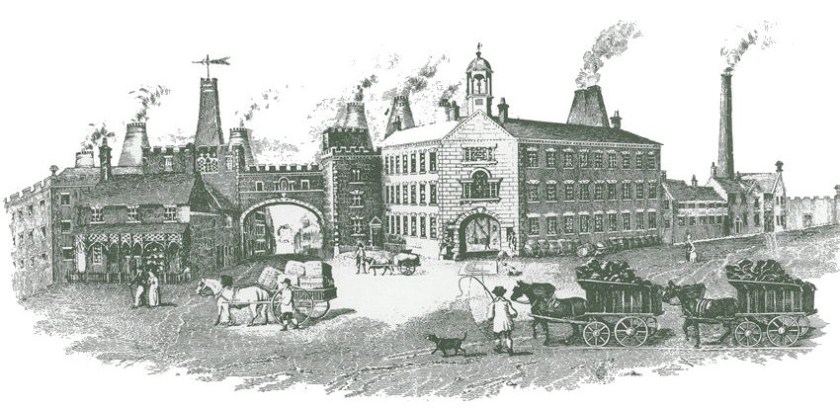This review gives a comprehensive description of the Doubletree by Hilton Stoke-on-Trent. It also introduces its readers to Middleport Pottery, the Emma Bridgewater Factory, the Gladstone Pottery Museum and Biddulph Grange Gardens.
Category: Stoke-on-Trent
Historic Tunstall: Absalom Read Wood (1851-1922)

Absalom Reade Wood was one of North Staffordshire’s leading Architects. He created Tunstall’s unique Victorian Civic Centre.
When Absalom Reade Wood died in 1922, North Staffordshire lost one of its leading architects. During his long life, Absalom had created numerous churches and chapels, houses and factories, schools and civic buildings throughout the district.
He was born at Burslem in 1851, and attended the town’s Wesleyan Day School. When he left school, Absalom was articled to Shelton architect Robert Scrivener.
Absalom was a small man, with ‘a comfortable, neat figure and a short beard’ and a warm, friendly personality that gave him an optimistic outlook on life. He was a keen sportsman who enjoyed cycling, swimming, and playing cricket, tennis, and golf.
He became an architect during the early 1870s and established his own practice in Tunstall in 1874.
A year later, Absalom became the town’s part-time surveyor, a position he held until the creation of the County Borough of Stoke-on-Trent in 1910. Working closely with John Nash Peake and the town clerk, Arthur Llewellyn, he modernised Tunstall’s market hall. He created the town’s unique late Victorian Civic Centre containing his piece de resistance the town hall, which opened in 1875.
Other civic buildings Absalom designed included Kidsgrove’s town hall and Longton’s Sutherland Institute. Burslem School Board employed him to build Jackfield, Park Road and Longport Schools.
Absalom married Mary Holdcroft, the daughter of pottery manufacturer William Holdcroft. The couple had five children – two boys and three girls. The Wood family were Methodist. They worshipped at Hill Top Methodist Church in Burslem. In 1889, Absalom was employed to enlarge and modernise the church.
Absalom’s best-known building in Burslem is the Art School in Queen Street. Situated on land opposite the Wedgwood Institute, which was given by Thomas Hulme, the school cost £8,500. The school opened in 1907, and one of its most famous alumni was pottery designer Clarice Cliff.
Clarice was born in Meir Street, Tunstall, on 20 January 1899. Before going to Burslem Art School, she attended High Street School, Tunstall, Summerbank Road School, Tunstall and Tunstall Art School, which was housed in the Jubilee Buildings in Station Road (now The Boulevard). High Street and Summerbank Road Schools were designed by Absalom, as were the Jubilee Buildings.
Absalom died at his home Hillcrest, Woodland Avenue, Wolstanton on 21 December 1922.
Absalom Reade Wood (1851-1922) is one of a series of articles about North Staffordshire’s history written by Betty Martin before her death. Other articles from the series will be posted from time to time.
Dare you visit Tunstall’s Spooky Market?

Tunstall Town Centre Community Association challenges you to come and shop at its Spooky Market. The market will be held in ‘the coffin’ at the Floral Hall in Tunstall Park on Saturday, 1st November. It opens at 12pm. As well as traditional market stalls, there will be fun and games, refreshments and live entertainment. You might meet a ghost. Who knows?
Longport in the 1790s
A Description of the Country From Thirty to Forty Miles Round Manchester, a book published in 1795, was compiled by Dr John Aikin. The book tells us about Newcastle-under-Lyme and North Staffordshire’s pottery towns and villages in the 1790s.
This edited extract from the book describes Longport in the 1790s.
Longport is situated in a valley between Burslem and Newcastle. There are some good buildings in it and several large pottery factories. Because it is in a valley, there are times when the smoke from bottle ovens and kilns hangs over Longport, making the air disagreeable, if not unwholesome.
The Trent & Mersey Canal passes through Longport, where there is a public canal wharf. Before the canal was constructed, Longport was called Longbridge Hays because there was a kind of bridge that ran parallel for a hundred yards with the Fowlea Brook. The bridge was dismantled when the canal was cut.
The number of buildings increased rapidly when the canal was completed, and the village’s name was changed from Longbridge Hays to Longport.
Friday NewsDesk
During the week, we have learned how to use a new scanner that can scan books without damaging them.
We have completed the first stage of our research into the growth of further and higher education in the Potteries. The research program examined vocational training from the early 19th to the end of the 20th century. It traced the history of Staffordshire Polytechnic and Stoke-on-Trent College.
During the project’s second stage, we will look at university and further education since the end of the 20th century.
Have a relaxing and enjoyable weekend. Stay safe and we’ll see you again on Monday.
Housing Plan Angers Local Residents
Stoke-on-Trent City Council has a fight on its hands. The council wants to build over 3,000 homes on two greenfield sites at Norton Green. There was widespread opposition to the schemes when they were discussed at a public consultation earlier this week.
Residents believe that the proposed developments will fundamentally alter the village’s character and destroy the local community.
Darren Gerrard, the chair of Norton Green Residents’ Association, said: “We love where we live. If this scheme goes ahead, the identity of the village will be lost… Norton Green could become the biggest building site in the city, and it’s all on greenbelt land.”
The association is encouraging local people to oppose the city council’s development plans. To help them challenge the proposals, the association is holding two drop-in sessions at Heakley Hall Farm. The first session is on Saturday, October 4, and the second on Saturday, October 18. Both sessions start at 12:00 p.m. and last until 4:00 p.m.
Celebrate Diwali at the Potteries Museum
Visit the Potteries Museum and Art Gallery on Saturday, October 18, to celebrate Diwali.
Diwali is the colourful and vibrant Hindu and Sikh Festival of Lights.
Visitors will see different traditional Indian dances performed by professional and semi-professional artists. They will show you Kathak, Bharatanatyam, Kaikottikali, Bhangra and Bollywood dances which come from different parts of India.
There will be stalls in the foyer where you can buy Indian clothes, jewellery and vegetarian street food.
The celebration starts at 11.00am and ends at 5.30pm. Free Admission.
High Energy Costs Could Kill the Pottery Industry
High energy costs are threatening the Pottery industry’s future.
Local firms are paying £875 million a year for the energy they use. An analysis by Nottingham Trent University indicates that Britain’s ceramic industry spends 70% of its turnover on energy and 14% on government and regulatory levies.
Energy costs for the pottery industry in America and China have not risen since 2020.
The analysis examined a company based in Stoke-on-Trent with 49 employees and a turnover of approximately £630,000. This year, the firm will be paying £443,000 for the energy it uses.
Pottery worker Sharon Yates said to delegates attending the Labour Party Conference: “I am a proud pottery worker – just like my dad before me. The most highly skilled potters make ceramics in my town and we export the round the globe. But the industry we rely on is dying.
Tell us what you think. Do you agree with Sharon? Is the pottery industry dying, or can it survive the high cost of energy? If the industry is on its last legs, what does the future hold for Stoke-on-Trent? Have your say and tell us what you think.
Burslem and Cobridge in the 1790s

This image shows Wood & Caldwell’s Fountain Place Works in Burslem. In the 1790s the company made Staffordshire figures, earthenware and stoneware. Enoch Wood and James Caldwell were partners in the firm. The firm owned Bycars Colliery, where it mined coal to fire the factory’s bottle ovens and kilns.
A Description of the Country From Thirty to Forty Miles Round Manchester, a book published in 1795, was compiled by Dr John Aikin. The book tells us about Newcastle-under-Lyme and North Staffordshire’s pottery towns and villages in the 179os
This edited extract from the book describes Burslem and Cobridge as they were in the 1790s.
Burslem
Burslem is the home of North Staffordshire’s pottery industry. Earthenware has been made there for many centuries. Dr Plot, in his History of Staffordshire, written in 1686, said that the factories making pottery in Burslem were the largest in the district…
The town has two weekly markets. A large market is held on Monday, and a smaller one is held on Saturday. Four or five years ago, cattle markets were established. These markets are well attended by cattle dealers and butchers.
Burslem is a parish in its own right. The parish church, St John’s, has a good organ. The church has recently been enlarged and regenerated.
There are a large number of [Wesleyan] Methodists in the district. The Methodists have built a large chapel in Burslem and erected chapels in several pottery towns and villages. There are many other religious sects in the Potteries. Few areas have such a great diversity of sincerely held religious opinions.
Cobridge
Cobridge is an industrial village where earthenware is made. It is partly in Burslem Parish and partly in Stoke Parish.
Celebrate Black History Month at the Potteries Museum and Art Gallery
Come to the Potteries Museum and Art Gallery on Saturday, 4 October to celebrate Black History Month.
The event is a creative cultural day that celebrates the art, music and food of people of African or Caribbean descent.
This year, Black History Month’s theme is ‘Standing Firm in Power and Pride’, a tribute to the resilience, strength, and unwavering commitment to progress that define the Black community.
During the day, there will be a wide range of events including craft workshops, dancing, music and singing, Ghanaian acrobatics, stalls and many more things to enjoy.
The celebration starts at 11 am and ends at 5 pm. Admission is free.